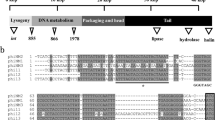Summary
The relationship between nine Haemophilus species and Haemophilus influenzae was studied by DNA-DNA hybridization, by transformation of H. influenzae to streptomycin resistance with heterospecific DNA, by competition of heterospecific DNA for transformation by homospecific DNA and by the lethal effect of heterospecific DNA on competent H. influenzae. H. parainfluenzae, H. parasuis, and H. aegyptius DNA transformed at more than 10% efficiency when compared to homologous transformation, but only H. aegyptius demonstrated, by hybridization, a relative binding ratio of more than 80%. H. aphrophilus and H. paraphrophilus DNA demonstrated a relative binding ratio of less than 30% and transformed H. influenzae at only 10-5 the efficiency of homologous DNA, but they competed for H. influenzae transformation as well as or better than homospecific DNA. The data indicated that in some of the species sharing the common ecological habitat of the mammalian respiratory tract, sequences necessary for competition and efficient uptake into H. influenzae are present in large numbers in their DNAs, which nevertheless have little overall homology with H. influenzae DNA.
Similar content being viewed by others
References
Alexander HE, Leidy G (1950) Transformation type specificity of H. influenzae. Proc Soc Exp Biol Med 73:485–487
Alexander HE, Leidy G (1951) Determination of inherited traits of H. influenzae by desoxyribonucleic acid fractions isolated from type-specific cells. J Exp Med 83:345–359
Alexander HE, Leidy G (1955) Origin of species in microorganisms: use of transformation as a tool. Am J Dis Child 90:560–561
Barnhart BJ, Cox SH (1968) Radiation-sensitive and radiationresistant mutants of Haemophilus influenzae. J Bacteriol 96:280–282
Beattie KL, Setlow JK (1970a) Repair of ultraviolet-irradiated transforming deoxyribnucleic acid in Haemophilus influenzae. J Bacteriol 101:808–812
Beattie KL, Setlow JK (1970b) Transformation between Haemophilus influenzae and Haemophilus parainfluenzae. J Bacteriol 104:390–400
Brenner DJ, McWhorter AC, Knutson JKL, Steigerwalt AG (1982) Escherichia vulneris: a new species of Enterobacteriaeae associated with human wounds. J clin Microbiol 15:1133–1140
Brunton JL, Maclean I, Ronald AR, Albritton WL (1979) Plasmidmediated ampicillin resistance in Haemophilus ducreyi. Antimicrob Agents Chemother 15:294–299
Danner DB, Deich RS, Sisco KL, Smith HO (1980) An elevenbase-pair sequence determines the specificity of DNA uptake in Haemophilus transformation. Gene 11:311–318
Danner DB, Smith HO, Narang SA (1982) Construction of DNA recognization sites active in Haemophilus transformation. Proc Natl Acad Sci USA 79:2392–2397
Deich RS, Hoyer LC (1982) Generation and release of DNA-binding vesicles by Haemophilus influenzae during induction and loss of competence. J Bacteriol 152:855–864
Dubnau D, Smith I, Morell P, Marmur J (1965) Conservation in bacillus species. I. Conserved genetic and nucleic acid base sequence homologies. Proc Natl Acad Sci USA 54:491–498
Hsu Y-C, Herriott RM (1961) Studies on transformations of Hemphillus influenzae. III. The genotypes and phenotypic patterns of three streptomycin-resistant mutants. J Gen Physiol 45:197–204
Kilian M, Frederiksen W (1981) Ecology of Haemophilus, Pasteurella and Actinobacillus. In: Kilian M, Fredericksen W, Biberstein EL (eds) Haemophilus, Pasteurella and Actinobacillus. Academic Press, New York, pp 11–38
Mannheim W (1981) Taxonomic implications of DNA relatedness and quinone patterns in Actinobacillus, Haemophilus, and Pasteurella. In: Kilian M, Fredericksen W, Biberstein EL (eds) Haemophilus, Pasteurella and Actinobacillus. Academic Press, New York, pp 265–280
Nickel L, Goodgal SH (1964) Effect of interspecific transformation on linkage relationships of markers in Haemophilus influenzae and Haemophilus parainfluenzae. J Bacteriol 88:1538–1544
Notani NK, Setlow JK (1972) Molecular events accompanying the fixation of genetic information in Haemophilus heterospecific transformation. J Bactriol 112:751–760
Pohl S (1981) DNA relatedness among members of Haemophilus, Pasteurella, and Actinobacillus. In: Kilian M, Frederiksen W, Biberstein EL (eds) Haemophilus, Pasteurella and Actinobacillus. Academic Press, New York, pp 245–253
Rosenberg AH, Simon MN, Studier FW (1979) Survey and mapping of restriction endonuclease cleavage sites in bacteriophage T7 DNA. J Mol Biol 135:907–915
Schaeffer P (1956) Transformation interspecifique chez des bacteries du genre Hemophilus. Ann Inst Pasteur 91:192–211
Schaeffer P (1958) Interspecific reactions in bacterial transformation. Symp Soc Exp Biol 12:60–74
Scocca JJ, Poland RL, Zoon KC (1974) Specificity in deoxyribonucleic acid uptake by transformable Haemophilus influenzae. J Bacteriol 118:369–373
Setlow JK, Boling ME, Allison DP, Beattie KL (1973) Relationship between prophage induction and transformation in Haemophilus influenzae. J Bacteriol 115:153–161
Sisco KL, Smith HO (1979) Sequence-specific DNA uptake in Haemophilus transformation. Proc Natl Acad Sci USA 76:972–976
Steinhart WL, Herriott RM (1968a) Fate of recipient deoxyribonucleic acid during transformation in Haemophilus influenzae. J Bacteriol 96:1718–1724
Steinhart WL, Herriott RM (1968b) Genetic integration in the heterospecific transformation of Haemophilus influenzae cells by Haemophilus parainfluenzae deoxyribonucleic acid. J Bacteriol 96:1725–1731
Voll MJ, Goodgal SH (1961) Recombination during transformation in Hemophilus influenzae. Proc Natl Acad Sci USA 47:505–512
Author information
Authors and Affiliations
Additional information
Communicated by G.R. Fink
Rights and permissions
About this article
Cite this article
Albritton, W.L., Setlow, J.K., Thomas, M. et al. Heterospecific transformation in the genus Haemophilus . Molec Gen Genet 193, 358–363 (1984). https://doi.org/10.1007/BF00330693
Received:
Issue Date:
DOI: https://doi.org/10.1007/BF00330693




